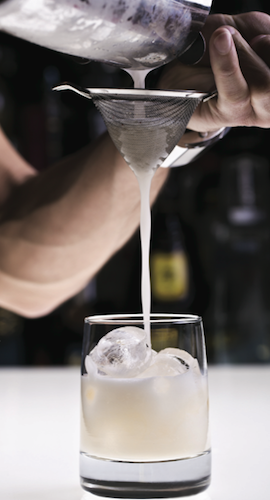..........................................................
"BARTENDERS HATE VODKA", is a line long-peddled by the trade. But it’s time to scrap this tired observation – very few bartenders in 2015 hate vodka. Some even like it. The business of vodka-bashing that was once an occupational obligation, designed to separate the serious from the unserious bartender, has fallen away of late. The point was made; the message heard. The wider industry now knows that bartenders are apostles of flavour and quality and are unimpressed by bland liquids and marketing that make them the extraneous middleman in the consumer- brand sandwich.
When was the last time you heard bartenders hammering vodka for its “marketing bollocks” or “tastelessness”? If it still happens in 2015, the broadsides are less frequent, less fervent. The question is, has vodka trashing simply become less trendy, or has the category improved in quality and message?
Ironically, inactivity may have contributed more than activity. In the first decade of the noughties, vodka launches crawled from every possible industry orifice. Everyone was at it, attempting to use marketing to transform bought-in spirit into liquid gold. But try to think of five new vodka brands to enter the fray and your mind will soon turn to last five gin launches. The fatigue for vodka has subsided with the slowing of category traffic. Gin industry: take note.
Jared Brown, historian and distiller of Sipsmith vodka, picks up the thread: “The bashing took place at a time when the [UK] Alcohol and Tobacco Tax and Trade Bureau was getting 40 applications for new vodka brands every month. Think about that. Every person who wanted to get stinking rich but didn’t have the least clue about the industry saw it as a way to jump in. They walked into bars, talked enough to reveal their ignorance and did a load of damage to an otherwise respectable spirit."
Balderdash bartender Geoffrey Canialo says the message was wrong: “Vodka marketing was never about the taste but the lifestyle it offered people.” The communication simply didn’t fit the changing times. It was based on purity achieved by filtration, so abraded against a profession that had begun to prize complex flavours - the very esters that became vodka’s casualties.
But as the sales story has morphed from infinite distillations and precious stone filtration to grain (and or other alcohol source ingredient) and texture, it is no coincidence that so has bartender opinion. For the trade, it’s always been a case of, if you want to be taken seriously, be serious about the liquid. Dutch Kills bartender Jan Warren neatly summarises: “As long as a liquor has flavour, it’s got a point.”
Even at the height of vodka hate, the spirit appeared on most menus. Paying to play is common among vodka brands and consumers have always demanded the spirit. But increasingly, vodka proponents are coming out from behind the bar, leaning towards quality, crafted vodkas. Small brands such as Konik’s Tail, Tito’s Handmade, Chase and Aylesbury Duck have all appeared in recent World’s 50 Best Bars Brands Reports. Jon Lister, ex-Purl bartender and now trainer at Speciality Brands, which represents Konik’s Tail says: “Bartenders are enjoying working with the finer nuances of well made vodka. Konik’s Tail is all about the grains and retaining the oils and flavour within, doing this gives texture and richness to work with.” Over at no.2 bar in the world, Dead Rabbit, Sean Muldoon thinks Chase vodka is a simply a well made, tasty spirit and would happily drink it.
But is vodka cool again? Perhaps not cool on the level of craft bourbon, tequila and mezcal, but perhaps that doesn’t matter. As a profession there seems less interest in outward appearance – the new cool is not caring about cool. Andreas Hastrup Nilsson of Strom, says he considers it now “snobbishness to neglect” the spirit while writer and bartender Naren Young says “only a rookie bashes vodka” – which seems wrong: “Vodka marketing was never about the taste but the lifestyle it offered people.” The communication simply didn’t fit the changing times. It was based on purity achieved by filtration, so abraded a profession that had begun to prize complex flavours – the very esters that became vodka’s casualties.
But as the sales story has morphed from infinite distillations and precious stone filtration to grain and texture, it is no coincidence that so has bartender opinion. For the trade, it’s always been a case of, if you want to be taken seriously, be serious about the liquid. Dutch Kills bartender Jan Warren in New York neatly summarises: “As long as a liquor has flavour, it’s got a point.”
Even at the height of vodka hate, the spirit appeared on most menus. Paying to play is common among vodka brands and consumers have always demanded the spirit. But increasingly, vodka proponents are coming out from behind the bar, leaning towards quality, crafted vodkas. Small brands such as Konik’s Tail, Tito’s Handmade, Chase and Aylesbury Duck have all appeared in recent World’s 50 Best Bars Brands Reports.
Jon Lister, ex-Purl bartender and now trainer at Speciality Brands, which represents Konik’s Tail says: “Bartenders are enjoying working with the finer nuances of well-made vodka. Konik’s Tail is all about the grains and retaining the oils and flavour within. Doing this gives texture and richness to work with.”
Over at the world’s number two bar, Dead Rabbit in New York, Sean Muldoon thinks Chase vodka is a simply a well made, tasty spirit and would happily drink it.
But is vodka cool again? Perhaps not on the level of craft bourbon, tequila and mezcal, but maybe that doesn’t matter. As a profession there seems less interest in outward appearance – the new cool is not caring about cool. Andreas Hastrup Nilsson of Copenhagen’s Strøm, says he considers it now “snobbishness to neglect” the spirit, while writer and bartender Naren Young says “only a rookie bashes vodka” – which seems to sum up the current feeling.




